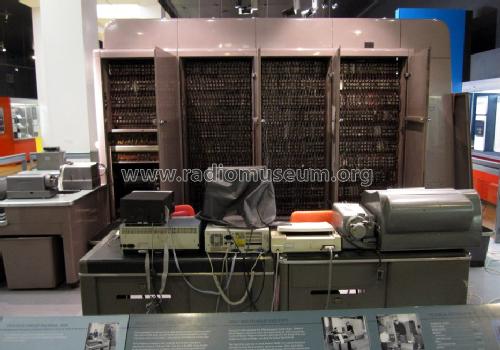Pegasus
Ferranti, GB
- Produttore / Marca
- Ferranti, GB
- Anno
- 1956
- Categoria
- Miscellanea (Altro, Varie) - vedere nelle note
- Radiomuseum.org ID
- 180764
- Gamme d'onda
- - senza
- Tensioni di funzionamento
- Rete (CA, universale, CC, o non nota)
- Altoparlante
- - - Nessuna uscita audio.
- Materiali
- Mobile di metallo
- Radiomuseum.org
- Modello: Pegasus - Ferranti, GB
- Forma
- Diverse forme (descritte nelle note).
- Annotazioni
- Pegasus was an early thermionic valve (vacuum tube) computer built by Ferranti, Ltd of Great Britain.
The Pegasus 1 was first delivered in 1956 and the Pegasus 2 was delivered in 1959. Ferranti sold twenty-six copies of the Pegasus 1 and twelve copies of the Pegasus 2, making it Ferranti's most popular valve (vacuum tube) computer. At least two Pegasuses survive, one in The Science Museum and one in The Manchester Museum of Science and Industry.
In 1956 the first Pegasus was used to calculate the stesses and strains in the tail plane of the first vertical take off aeroplane, the SR53; the results were used to check the manufacturers figures; the programmer was Anne Robson. Because of the importance of a computer it was housed in the drawing room, complete with an Adam's ceiling, of Ferranti's London office in Portland Place.
In 1957, a Pegasus computer was used to calculate 7480 digits of pi, a record at the time.
(Part of the text in this page is from Sciencemuseum Object wiki, distributed under Creative Commons license: Attribution-ShareAlike 2.0).
- Autore
- Modello inviato da Alessandro De Poi. Utilizzare "Proponi modifica" per inviare ulteriori dati.
- Altri modelli
-
In questo link sono elencati 220 modelli, di cui 125 con immagini e 166 con schemi.
Elenco delle radio e altri apparecchi della Ferranti, GB
Musei
Il modello Pegasus può essere visto nei seguenti musei.
